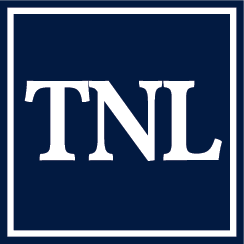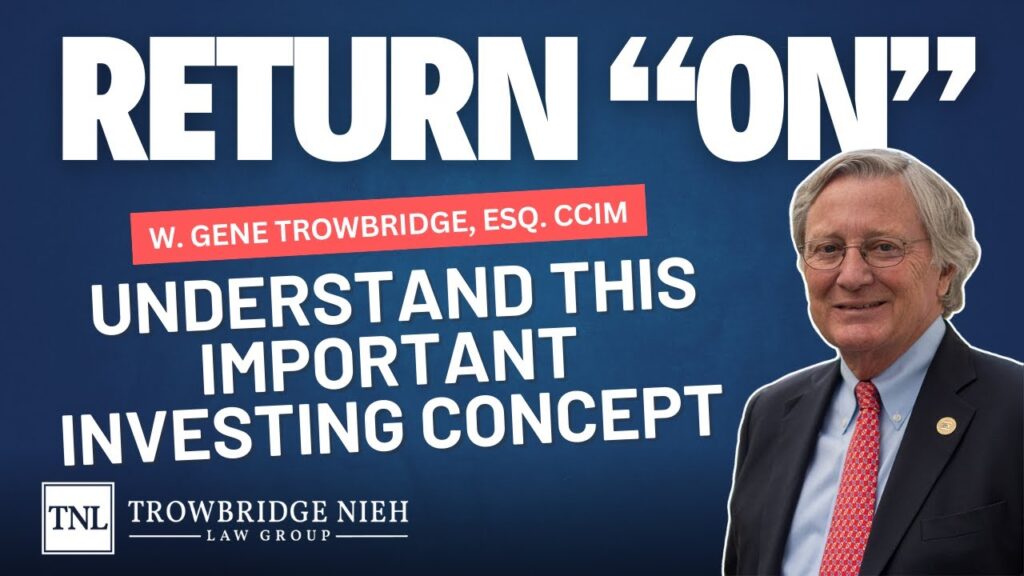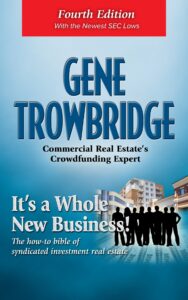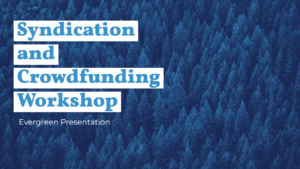Most Important Sections of YOUR PPM!
In this episode of TBD with TLG, syndication and crowdunding attorneys Gene Trowbridge and Jon Nieh discuss the 4 MOST important sections of the Private Placement Memorandum for YOUR securities offerings.
Transcript
 | JN | Hey everybody. Welcome to another episode of TBD with TLG. I'm one of your hosts, Jonathan Nieh, from Trowbridge Law Group. I'm joined today with my partner, Mr. Gene Trowbridge. Hi Gene! |
 | GT | Hi, Jonathan! You're looking good today. I can't wait to have you tell us what the topic is. |
 | JN | So people probably think that we, we we actually do think about the topics beforehand, but no, we actually don't. We come up them literally like 10 minutes before the show. But today this, this this episode of TBD with TLG is going to be the top four sections, the four most important sections of the PPM, the private placement memorandum. So, you know, what is the PPM, first of all? The PPM, private placement memorandum, that's what it stands for, it's basically the disclosure document that you have to give to your investors. If you're syndicating a deal, if you're doing a 506 , 506 , any Reg D deal, you have to, you have to have a PPM. You have to, you know, give certain disclosures to your investors. The PPM has all the disclosures. You know, some of the sections that we're not really going to delve into today include, you know there's a huge section about risks, all the risks involved in the deal, you know, risks involved with investing in real estate, general risk investing. Other sections include conflicts of interest, dispute resolution, that's an important section, liquidity, voting rights, but the four most important sections of the PPM that we're going to talk about today are sections two, three, four, and five, which are section two's, you know, information about the company, like organizational information. Section three is "Sources and Uses". Section four is "Distributions", and section five is "Fees". So I'll be talking about the first two sections, sections two and three. And then I'll let you talk about four and five, Gene. Sounds good? |
 | GT | Sounds good. |
 | JN | Well, so section two, section two of the PPM is titled "Summary of the Company". So, I should probably point out that this is all based on our documents, what we draft for our clients, our PPM. You know, if you go to another attorney another law firm, they might draft it differently, but this is how we put together our PPM for our clients. So in our PPM, section two is titled "Summary of the Company". So it's going to talk about, well, first of all what type of company it is. So for our clients, we use LLCs. So it's going to have the name of the LLC. It's going to have the address of LLC. It's going to talk about how the LLC is structured, right? So, usually for a syndication, it's going to be a manager |
 | GT | Probably the information about the manager? |
 | JN | I thought I |
 | GT | And then a lot of that stuff that, that really applies to organization information about the company and the property specifically in our documents, we put in a self |
 | JN | Mm. |
 | GT | Exhibit number four is the investment plan, the property package, whatever you want to call it. And so we'll have a paragraph on the property, but we'll say, look at Exhibit four, and here comes the sponsors package with pictures and rent rolls and projections and all that. We keep that separate so that the offering document doesn't get to be, you know 7,000 pages long and as you're doing your due diligence, something changes, let's just change the property package, not the whole entire document, and that's the way we, that's the way we structured. And as Jonathan said, we're talking about section two in our document. It's, this information's going to be in everyone's document. All four of the things we're going to talk about will be in everyone's document. They just might not be in sections two, three and four, two, three, four, and five the way we do it, because there's a structure on how a PPM is drafted, but there is some art to the storytelling. And we've, Jonathan and I have developed this art form because we think this is the best way to tell the story and draw the investor's attention to what's important right off the bat. |
 | JN | Yeah. Sorry, I forgot to mention the PPM is the story of your offering. That's that's what we always say. That's what Gene always says. So yeah, I mean, we like to structure it a certain way. I think it makes sense once you see all of our documents together. You know, we're just talking about the PPM right now, but we like to draft the PPM so it kind of flows nicely with the operating agreement, right? So, you know, section two of our PPM kind of matches article two of the operating agreement. Same with, you know, four and five. So that's why we, you know, we draft it the way we do. And, you know, I think ours is pretty good. I mean, I've seen some other ones out there, and you know, ours is very readable, right? So it's very, you know, it doesn't use a lot of legalese, I think. |
 | GT | But we use plain English. |
 | JN | Yeah. Yep. |
 | GT | Plain English as much as we can, right? |
 | JN | Yeah. Well, we try to, yeah. All right, moving on. So second three of our PPM is titled "Sources and Uses of Proceeds". So, this is also required. I mean, you have to, you have to t |
 | GT | Yeah. I actually think the percentage columns are the most important, because if I'm looking at two offerings, I'm looking at an offering, let's just say that... let's forget minimum, maximum. Let's just say maximum 5 million. Okay, and these are the dollar amounts where they're going to go. And I'm looking at an offering of 7 million. These are the dollar amounts, where are they going to go? It's kind of hard to compare just based on dollar amounts. So the SEC says, "Put those percentage columns in there." So if I'm going to look at two, three different offerings, I can say, "Okay, on a range, I wouldn't want my acquisition costs and upfront fees to be more than 7%. Okay. Oh, this one's 10! Well, maybe I'm going to discount that one." But you really can't tell by just the dollar amount. You need the, you need the percentages, and that's why we do it. I don't know if the marketplace looks at that. First of all, we're required to do it that way, and secondly, there's a good reason for that, but that's why we do the percentage, that percentage lists. Okay, then. So those are two good, important deals. We've got organization information about the company. We follow right through telling people what are we going to do with all this money we're going to raise? And Jonathan said, there's a minimum and a maximum column. An example of why you'd have that is, let's say you're going to do all your rehab work with cash that you raise. You need 2 million to close, but there's another 2 million for the rehab. Well, your minimum column would be the 2 million. Let's get that 2 million raised, and let's close the deal. Then we can continue to raise money for the next 2 million, which makes it a 4 million dollar offering, and that next 2 million is for rehab, but we don't need that to get to the closing date of August 31st. We only need the 2 million. So we, we break it down like that to make it easier for the sponsor |
 | JN | No. I just wanted to point out that, I mean, we were talking about what we think are the four most important sections of the PPM, but the whole document |
 | GT | Well we're right! We're right! We're right. |
 | JN | We are right. But I mean, the whole document is important, right? So you, if you're a client, you should definitely read the entire document and understand every section, but these are the four sections that you'll probably get the most questions from your investors about. |
 | GT | Let's take just a second and brainstorm, just you and me, throw out sections, other than this, that you think people should read. I'm going to throw out one, then you can come back with one. Liquidity! |
 | JN | I was going to say liquidity. |
 | GT | Liquidity for the investors. What's, what's one from you? |
 | JN | Tax, tax issues. |
 | GT | The tax section. Conflicts of interests. Hey, I'm a sponsor. I've got 20 deals on the streets. You know there's some conflicts |
 | JN | Suitability standards |
 | GT | Suitability, who should invest? Risk. Say we only have a five |
 | JN | Hmm. Oh, the definition section that's important. |
 | GT | The definition section is really good. Voting rights! |
 | JN | Mm. Mhm. |
 | GT | We've got to talk about voting rights. What can the investors vote on, and what can they not vote on? Very, very, very interesting. So, I think we just probably covered everything that's in the, in the, in the PPM, and all that stuff gets flown into the operating agreement. So maybe someday we'll have a session` on the operating agreement. What do you think? |
 | JN | Yeah, I think that's a good idea. If you guys think that's a good idea |
 | GT | To be determined? |
 | JN | Write in the comments, what you guys think, if we should talk about the operating agreement next, or, you know whatever topic that we should talk about next, Um, but yeah, I mean, thank you everyone for watching another episode of TBD with TLG. Same time next week, Oh! Make sure to like and subscribe. If you do subscribe to our channel, make sure that you do it publicly so that we could see, and you might, you know, be able to win a copy of Gene's book, maybe a an autographed copy of Gene's book. So yeah, like and subscribe our videos. We will see you guys next week. |
 | GT | Good session, thanks Jonathan! |
 | JN | Thanks Gene! |




